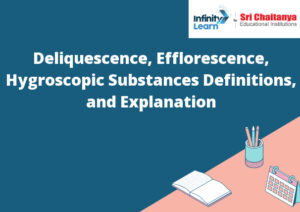Table of Contents
Deliquescence
Deliquescence, Efflorescence, Hygroscopic Substances Definitions, and Explanation
Deliquescent: Deliquescent substances form an aqueous solution by absorbing water vapor.
Efflorescent: Efflorescent substances do not form a solution.
Hygroscopic: Hygroscopic substances do not form a solution, but absorb water vapor.
It is the process by which a solid material dissolves in a liquid to form a solution. The solid material can be an ionic compound, such as NaCl, or a molecular compound, such as ethanol. In the deliquescence process, the solid material absorbs water vapor from the air until it reaches a point where the vapor pressure of the water in the solid is equal to the vapor pressure of the water in the air. At this point, the solid material begins to dissolve in the liquid to form a solution.

Define Deliquescence
It is the process by which a solid material, generally a salt, absorbs moisture from the surrounding environment and dissolves to form a liquid. This process is often used to absorb water from the air, which can then be used for hydration or other purposes.
Efflorescence
is a white powder that is often seen on the surface of masonry. It is caused by the evaporation of water from the masonry. The water picks up salt from the masonry and carries it to the surface. The salt crystallizes on the surface and the powder is the result.
Hygroscopy
- Hygroscopy is the ability of a substance to attract and hold water molecules from the surrounding environment. This often exhibited by the substance’s ability to dissolve in water, as well as its high humidity absorption rate.
- Hygroscopic substances tend to have a high affinity for water, which allows them to absorb moisture from the air. This can be beneficial for substances that are used in a humid environment, as it helps to keep them moist. However, it can also be a disadvantage for substances that are used in a dry environment, as it can lead to them becoming damp and unusable.
Drying Agents
- Some products, such as paints, adhesives and solvents, contain volatile organic compounds (VOCs) that can give off harmful fumes. A drying agent is a substance that helps to speed up the evaporation of these harmful compounds. Drying agents work by absorbing the liquid component of the fumes, leaving the vaporized VOCs behind. This allows the fumes to dissipate more quickly, reducing the risk of exposure.
- One common drying agent is calcium chloride. It is a white, crystalline substance that is used in a variety of applications, including as a dehumidifier and a desiccant. Other drying agents include activated carbon and silica gel.
Difference between Efflorescent Substances, Deliquescent Substances, and Hygroscopic Substances
The three types of substances are efflorescent substances, deliquescent substances, and hygroscopic substances.
- Efflorescent substances are substances that effloresce or become powdery when exposed to the air. This is due to the loss of water molecules from the surface of the solid.
- Deliquescent substances are substances that dissolve in water to form a liquid. This is due to the absorption of water molecules by the solid.
- Hygroscopic substances are substances that attract water molecules from the air. This is due to the presence of hydrophilic groups on the surface of the solid.









